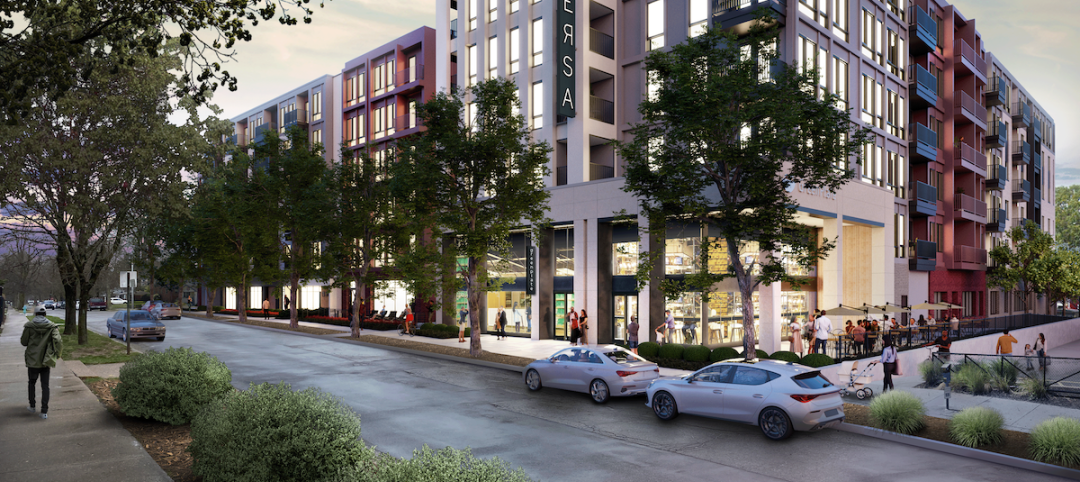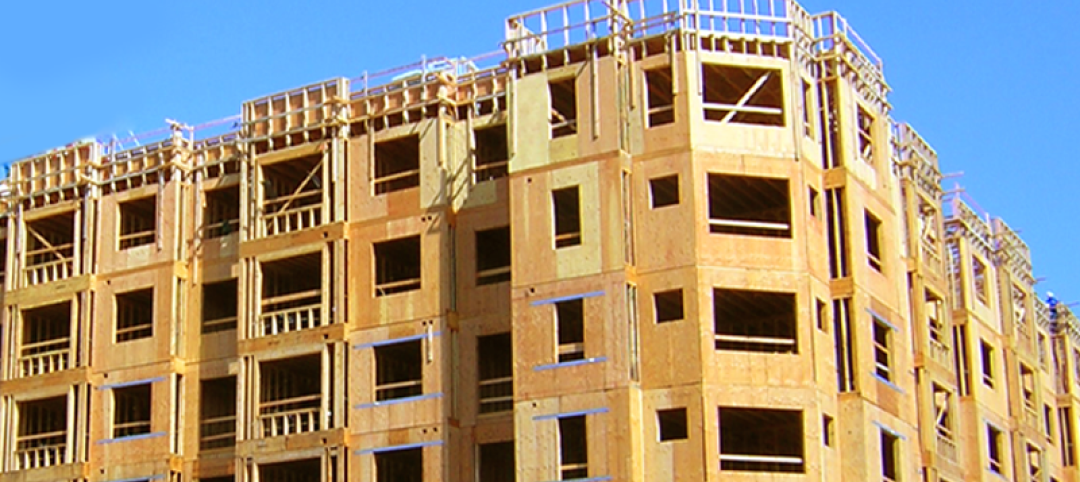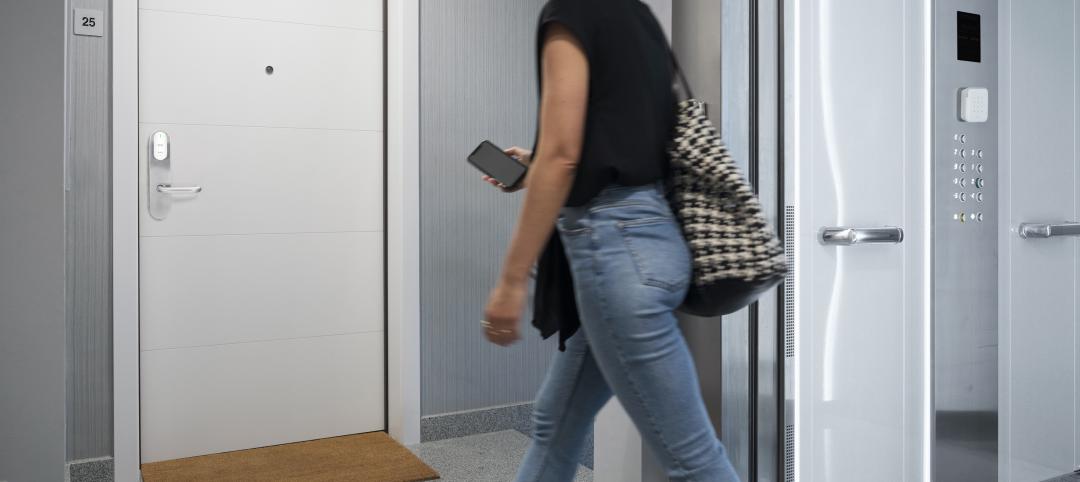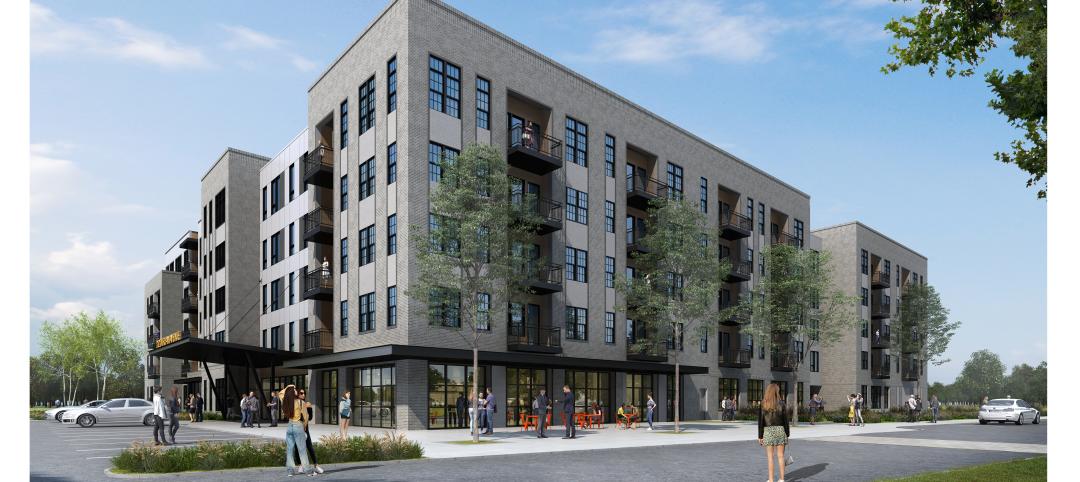There’s a construction boomlet under way in dog-washing facilities at U.S. and Canadian apartment and condominium communities.
Half of U.S. dog owners live in the 25 largest U.S. metro areas, where dog-focused amenities are common at apartment and condominium properties. More than half (55.2%) of respondents to this publication’s 2017 “Amenities Survey” said they had installed a dog-wash spa in a multifamily project.
Dog ownership has risen 29% in the past decade, claims pet-food market researcher Packaged Facts. According to the American Veterinary Medical Association, singles and renters make up the fastest-growing group of new dog owners.
Dog-washing stations provide renters and condo owners with an on-site amenity that’s a lot more practical than bathing a pup in a ceramic or fiberglass tub intended for humans. “Most tubs in multifamily building units have a conventional kitchen sink drain that can easily clog with dog fur, leading to maintenance and hygiene issues,” said Gary Sherman, Founder/CEO, Evolution Dog Wash Company, Los Angeles, who has installed about 50 such systems in residential buildings in North America.
The cost of installing a dog wash station can run from $3,500 to $8,000 per tub with all equipment, said Dan Hembree, President, Hemcor Construction, Cary, N.C. Some multifamily communities offer it as a free amenity; others charge a one-time fee or a per-use or monthly fee.
We asked four experienced professionals about installing these amenities. Here’s what they recommended.
Select a convenient location. Our experts recommend locating the dog-wash stations close to elevators, with easy access to the exterior, if possible.
The dog spa at the 41-story Quartz at City Place condominium tower in downtown Toronto is adjacent to a small outside dog park, which is accessible through a side entrance. “Residents can whisk their muddy dogs inside quickly and without tracking them through the main lobby area,” said Dominic De Freitas, ARIDO, IDC, NCIDQ, Vice President of Residential Development at interior design firm figure3, Toronto.
Size it right. Dog-washing spaces range in size from 100 sf to more than 1,000. The most basic house a utility sink and a few prefabricated stainless-steel tubs, said architect Brian Romanelli, Associate, Solomon Cordwell Buenz, Chicago. Larger, more sophisticated dog spas feature custom-designed systems with wall-mounted blow dryers and grooming tables. Rooms should be adequately sized to give dog owners easy access to all equipment, he said.
Connect the space to other pet amenities. At AMLI Residential’s new AMLI Arc luxury apartment tower in downtown Seattle—a city where pets far outnumber children—the “Canine Social Club” in the 12th-floor amenities space has a dog spa with two self-serve washing areas and a grooming station with a hydraulic lift. The space is adjacent to an indoor-outdoor pet lounge that’s connected to a semi-outdoor dog run with artificial turf.
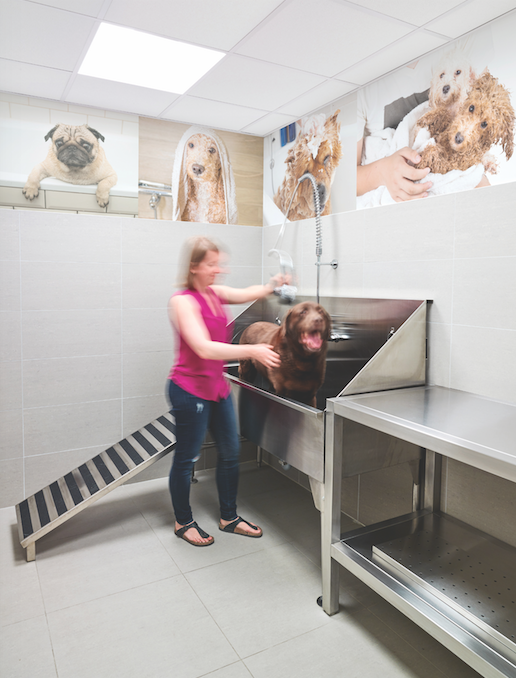
The dog-washing station at the Quartz Condos at Concord CityPlace in Toronto. Photo: Steve Tsai
“We were able to create a large, playful space that benefits both the residents and their pet family members,” said Camilla Watson, Interior Designer, ZGF Architects, Seattle.
Where there are multiple tubs, position the water valves on opposite sides of the tubs, so that two dogs aren’t facing each other while bathing. “Helps avoid conflict,” said Hembree.
Provide a ramp for the dogs, especially larger species, to get into the tub. “It can be a strain to hoist and control a rambunctious pup who isn’t crazy about getting wet and soapy,” said Sherman.
Never ignore aesthetics. Developers want to avoid making dog-grooming spaces feel like utilitarian, back-of-house facilities, said De Freitas. “There’s more of a focus to create a spa-like environment, especially in purpose-built rental projects,” he said.
At the Sinclair, a 35-story, 390-unit luxury apartment tower in Chicago’s Gold Coast neighborhood, the finishes in the dog spa are consistent with the project’s other amenity spaces. “Tile floors, wainscoted walls, custom decorative lighting, and natural-toned finishes were incorporated throughout the space” as requested by the developer (Fifield Companies), said Romanelli.
Pay close attention to maintenance, air quality, and noise. Select wall and floor finishes that are easy to clean and resistant to moisture, including slip-resistant floors with a dog-friendly coating, said Romanelli. “It’s also important to provide adequate ventilation to ensure that no strong odors leave the room.” Sound-absorbing ceiling tiles and other acoustical treatments can prevent boisterous barks from penetrating into adjacent spaces.
Make sure electrical outlets are designed to accommodate hair dryers—in some cases, a 220-volt receptacle may be needed. Install wall-mounted hair dryers within easy reach of human users. If necessary to avoid accessibility problems, have the manufacturer weld custom brackets underneath the grooming table, said Hembree.
Specify non-slip grooming mats on drying tables. “A good rubber mat allows the wet animal to stand comfortably without fear of slipping,” said Hembree.
Look into built-in storage. The dog spa at AMLI Arc has open bins for residents to store their supplies short-term and lockers for long-term storage, said Watson.
Build community. Pet owners gravitate toward other pet owners, and dog-washing stations can serve as social connectors in multifamily communities. “We’re seeing a big push to create a community-like environment within a building,” said De Freitas. “As these spaces continue to get larger, they’re inevitably going to become more social as well.”
At a new apartment building De Freitas is designing in downtown Toronto, the glass-fronted dog-wash room will be clearly visible from the main lobby. “We want the lobby to feel active and conducive to community,” he said. “So many people in these buildings have dogs. We’re trying to celebrate that, instead of hiding it.”
Prepare for future enhancements. De Freitas predicts that professional dog-grooming services, such as nail trimming and shearing, will become more common as developers and property managers test new and more elaborate pooch-friendly services.
Related Stories
Multifamily Housing | May 30, 2023
Milhaus, Gershman Partners, and Citimark close on $70 million multifamily development in Indy
Versa will bring 233 studio and one- and two-bedroom apartments to Indianapolis's $271 million, Class-A Broad Ripple Village development enterprise.
Multifamily Housing | May 23, 2023
One out of three office buildings in largest U.S. cities are suitable for residential conversion
Roughly one in three office buildings in the largest U.S. cities are well suited to be converted to multifamily residential properties, according to a study by global real estate firm Avison Young. Some 6,206 buildings across 10 U.S. cities present viable opportunities for conversion to residential use.
Multifamily Housing | May 19, 2023
Biden administration beefs up energy efficiency standards on new federally funded housing
The Biden Administration recently moved to require more stringent energy efficiency standards on federally funded housing projects. Developers building homes with taxpayer funds will have to construct to the International Energy Conservation Code (IECC) 2021 for low-density housing and American Society of Heating, Refrigerating and Air-Conditioning Engineers ASHRAE 90.1 for multi-family projects.
Sponsored | Multifamily Housing | May 19, 2023
Shear Wall Selection for Wood-Framed Buildings
From wall bracing to FTAO, there are many ways to secure the walls of a building. Learn how to evaluate which method is best for a project.
Sponsored | Multifamily Housing | May 17, 2023
The Key To Multifamily Access Control — Consistent Resident Experiences
Explore the challenges of multifamily access control and discover the key to consistent user experiences with a resident-first approach and open platforms.
Affordable Housing | May 17, 2023
Affordable housing advocates push for community-owned homes over investment properties
Panelists participating in a recent webinar hosted by the Urban Institute discussed various actions that could help alleviate the nation’s affordable housing crisis. Among the possible remedies: inclusionary zoning policies, various reforms to increase local affordable housing stock, and fees on new development to offset the impact on public infrastructure.
Multifamily Housing | May 16, 2023
Legislators aim to make office-to-housing conversions easier
Lawmakers around the country are looking for ways to spur conversions of office space to residential use.cSuch projects come with challenges such as inadequate plumbing, not enough exterior-facing windows, and footprints that don’t easily lend themselves to residential use. These conditions raise the cost for developers.
Multifamily Housing | May 12, 2023
An industrial ‘eyesore’ is getting new life as an apartment complex
The project, in Metuchen, N.J., includes significant improvements to a nearby wildlife preserve.
Senior Living Design | May 8, 2023
Seattle senior living community aims to be world’s first to achieve Living Building Challenge designation
Aegis Living Lake Union in Seattle is the world’s first assisted living community designed to meet the rigorous Living Building Challenge certification. Completed in 2022, the Ankrom Moisan-designed, 70,000 sf-building is fully electrified. All commercial dryers, domestic hot water, and kitchen equipment are powered by electricity in lieu of gas, which reduces the facility’s carbon footprint.



